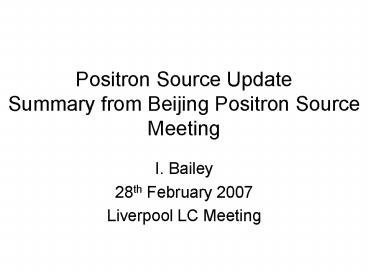Positron Source Update Summary from Beijing Positron Source Meeting - PowerPoint PPT Presentation
1 / 31
Title:
Positron Source Update Summary from Beijing Positron Source Meeting
Description:
... pump and cryocooler running already under vacuum and cold ... does NOT work with e- polarization only. sensitivity to new physics (CP violation, graviton) ... – PowerPoint PPT presentation
Number of Views:48
Avg rating:3.0/5.0
Title: Positron Source Update Summary from Beijing Positron Source Meeting
1
Positron Source UpdateSummary from Beijing
Positron Source Meeting
- I. Bailey
- 28th February 2007
- Liverpool LC Meeting
2
Overview of Activity
- Reference Design Report
- Target Hall
- Target Systems
- AMD (not in this summary)
- Undulator (not in this summary)
- Laser Compton (not in this summary)
- Polarisation and accelerator physics
- (http//hirune.kek.jp/mk/ilc/positron/IHEP/)
3
Current Design
4
Target Hall and Radiation Issues
5
Alternative Target Hall Layout
- Micro target hall
- 1 target station
- Surface reprocessing
- 8 of full target-hall size (100m2)
V. Bharadwaj, 17th October 2006
New baseline.
6
(No Transcript)
7
(No Transcript)
8
(No Transcript)
9
(No Transcript)
10
(No Transcript)
11
Target Geometry Drawn in SimpleGEO
Drive shaft(includes water channel)
Target wheel (includes water channel)
5 cell rf cavity.
L. Fernandez-Hernando,DL, 25/01/2007
e.g. s/c OMD
- A few glitches found in exporting geometries
between SimpleGEO and FLUKA. - Should be able to begin simulations in a few
weeks.
12
Target Removal/Replacement Showing Storage Cell
M. Woodward, 24th Jan 2007
Beam Pipe
13
Estimated Target Changeover Times
M. Woodward, 24th Jan 2007
28 Hours Removal
14
Estimated Target Changeover Times
25 Hours Replacement
M. Woodward, 24th Jan 2007
15
Target Systems
16
Stage 1 Prototype Target Wheel
Sectional view
- 1m diameter wheel with simplified structure
compared to current baseline target wheel. - Optional cantilever drive shaft (deflection
measurements) - Consistent with water-cooling (to be confirmed by
LLNL) - Uses Rigaku ferrofluidic feedthrough and is
consistent with Deublin water union. - Motor being sized for rotation up to 2000rpm.
17
Stage 1 Prototype Target Wheel and Test Magnet
Sectional view
18
Rotating disk experiment
Electra model of copper disk
Variable magnet gap
Permament magnet NdFeB properties defined from
optimiser fit
Conductor initial model copper 1.68e-8Om
19
Rotating disk experiment
Eddy currents A/mm2 _at_2000rpm
Unit vectors
20
Final model results for all gap spacing's
Rotating disk experiment
Models use 0.75 times conductivity of high cond
copper
21
Final model results for all gap spacing's
Rotating disk experiment
Models use 0.75 times conductivity of high cond
copper
22
ILC wheel model
Eddys _at_ 2000rpm
23
ILC wheel model
Power required to drive wheel _at_ different
rotational speeds Integrate power dissipation in
wheel volume directly in model I2r Model-torque
calculated use this to calc power provided by
braking force Should be equivalent
The large power required to drive the wheel may
pose a problem in the design.
24
Polarisation and Accelerator Physics
25
Advantage e Polarization
- No doubts 60 e polarization are needed
- What about 30 for the beginning?
26
Peff
- Increase of effective polarization
For comparison old LC studies (60,40)? Peff
0.8
27
Transverse polarization
- does NOT work with e- polarization only
- sensitivity to new physics (CP violation,
graviton)
Rizzo
MH1.5 TeV, E500 GeV, L500 fb-1
28
Physics goal
29
Summary Conclusion
- 30 is benefit for physics
- we could have a polarized machine from the
beginning! - Allows test of operation with both beams
polarized - ? should be used for physics otherwise it has
to be destroyed - (see also slides from L. Malysheva / I.
Bailey) - Utilization of low e polarization needs
- - Positron polarization measurement
- - Spin rotation
- frequency? Desired train-by-train
- proposed scheme exists spin rotators
before (LTR) and - after the DR (RTL) are needed
(see SLAC-TN-05-045, -
EUROTeV-Report-2005-024-1) - other solutions for helicity
reversal? - no reversal is worse than no
polarization! - Further design simulation work has to be done
and should include the 30 option
(depolarisation, polarimeter, spin-flip-frquency
etc.)
30
WP2.3 Recent Progress
Beam-Beam Simulations.
- Obtained first results from applying SLICKTRACK
to the main linac lattice. - Implemented first higher-order corrections into
CAIN beam-beam simulation (see panel on right)
including final state polarisation. - Completed theoretical study of approximation used
for anomalous magnetic moment in T-BMT equation
implemented in CAIN. This approximation has been
shown to be valid! - Compared SLICKTRACK and BMAD simulations for beam
delivery systems. - Begun first steps towards long term goal of
including non-linear transfer maps into
SLICKTRACK software package. - Expanding group of collaborators.
Polarised cross-sections for incoherent
Breit-Wheeler pair production added to CAIN
Tony Hartin
31
WP2.3 - Remaining Milestones and Future Plans
- The motivation for a complete cradle to grave
spin tracking simulation has grown as the high
energy physics community has increasingly
identified the importance of polarised beams as a
means to offset any reduction in ILC luminosity. - This work has been identified as high priority by
the Global RD board. - We have simulated most of the machine but not yet
in a fully integrated fashion. - We need
- Further development of SLICKTRACK for full
non-linear spin motion study of BDS and study of
main linac. - Further development of positron source simulation
including effects such as beam jitter and the
investigation of spin flip techniques. - Theoretical work on beam-beam interactions.
- A continued rolling study of the whole machine to
allow optimum use of polarisation as a tool for
the ILC.































